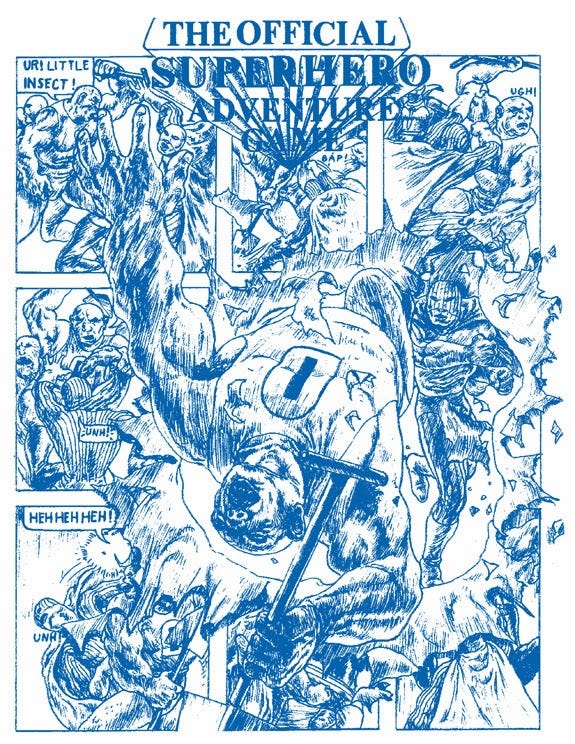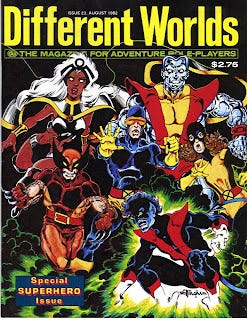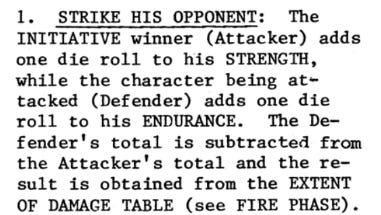Lost and Forgotten Games: "The Official Superhero Adventure Game" by Brian Phillips
Heartbreaker RPGs Aren't Just Fantasy.
Why a Series of Articles on Lost and Forgotten Games?
With the emergence of the role playing game "Old School Renaissance" in the mid-2000s and the growth of the indieRPG scene, we have seen a number of excellent gaming products released over the past few decades. In many ways, it reminds me of the heady days of yester-yore when gamers had "heard" of this newfangled thing "Dungeons & Dragons" and had a vague concept of what a role playing game was. During the early days of the role playing game hobby, there was an explosion of creativity as the market defined itself. Any glance at the table top gaming options on itch.io, the stream of new Kickstarters, or the catalog at DriveThruRPG.com, shows that we are in a heyday of creativity.
To be fair, there have been several explosions in role playing game history. There was the garage explosion of the 70s and early 80s where a number of products -- both wonderful and awful -- were created by gaming communities to be shared with friends and sometimes for profit. The best of these games led to the creation of new gaming companies. Flying Buffalo entertainment may have started as a play-by-mail game company, but it was Tunnels & Trolls that really got the company rolling.
There was the "corporate" explosion of the mid to late 80s where companies that had once been garage companies exploded with products to become relatively large ventures. Look at the product lines of FASA, Judges Guild, TSR, and Steve Jackson Games during this era. FASA, TSR, and Steve Jackson Games in particular became relatively large companies in the 1980s, even as two of these companies retained a distinctly independent feel.
Attempts to enter the market by gaming giants like Avalon Hill and SPI sparked this age where production values increased and new marketing strategies emerged. The 90s brought another surge of independent companies who capitalized on a mature but unsaturated market to bring in new gamers and new games. Companies like Pinnacle Entertainment and White Wolf emerged in this era with new games that had inspired settings and mechanics. Then came the d20 explosion of the early 2000s where a large number of companies, big and small, rode the coat tails of one of the largest gaming releases in RPG history. This era also saw the emergence of some small players, but it wasn't until the d20 bubble burst that the works of these wonderful independent creators began to receive their due.
Every era has had many games to offer and experience, but we only have so much time to engage with our hobbies and some games get lost, overlooked, or forgotten. The purpose of my [Lost Games] series, which will have a new entry every couple of weeks, is to highlight some of these games. Sometimes they will be games that I own and enjoy. Sometimes they will be games that have a large community of devoted fans. Other times, like today, they will be games that are lost and difficult to find.
The Official Superhero Adventure Game
I own almost every super hero role playing game ever published. From Superhero 2044 (original and revised) and Supergame (the next entry in this series) to Icons and Hideouts & Hoodlums, my collection runs deep. A personal favorite is Supercrew, which I’ll post a review of next week. There have been a few games that managed to slip past my superhero rpg obsession net though, and one of those games is "The Official Superhero Adventure Game."
Superhero 2044 -- A Look Back at the First Published Superhero Roleplaying Game
Preface Because Superhero 2044 is a very old and rather obscure game, I’m going to write a big of a preface here. Additionally, I will be posting a YouTube video that repeats much of this essay because I want to share this information in as many places as possible. I have two reasons for my particular enthusiasm here. First, I am a HUGE fan of superhero …
According to Heroic Worlds, "The Official Superhero Adventure Game" was self-published by Brian Phillips in 1981 in two separate editions (much like Supergame had two back to back editions). The first edition featured a 52 page rule book and 32 card stock sheets and a blue and white cover. The second edition, published the same year, also featured a 52 page rule book and 32 card stock sheets with a color cover replacing the blue and white one. Lawrence Schick, the author of Heroic Worlds is less than kind in his comments regarding the game and describes it as a, "Superhero system of confused, rudimentary rules, mainly for combat (basic and advanced). Includes dozens of hero and villain character descriptions."
Even if this were the only review available for the game, I would have hunted down a copy. It took me years to find one, but the thought of having a game that included of dozens of character descriptions, regardless of the overall quality of the game, is something that can provide a nice jumping off point to inspire other games. Though I don't get to play them as often as I like, super hero games are my favorite games to play in and run and any game that has more NPCs for me to convert to my favorite systems the better.
This isn't the only review available for the game; the Save vs. Dragon blog has a much kinder review of Brian Phillips creation in its discussion of the game and I share the author of that blog’s opinion. There is also another professional and contemporary review in the invaluable August 1982 issue of "Different Worlds" magazine (Issue #23). In what is maybe the single most important issue of a gaming related magazine for those interested in the history of super hero role playing games, there is a much more detailed review by gaming great Steve Perrin who writes:
The rules do provide a 'role-playing game,' but that section simply gives hints for role-playing the characters provided, also providing a somewhat looser scenario plan with another plot and more options for the referee. In fact, this is the only scenario that needs a gamemaster. The previous ones can be played by two players, each taking a side to manipulate.
One interesting aspect of the last chapter is the experience point system. Rather than giving points to the character, the points are given to the player, bot for his playing ability and his role-playing. Thus the characters remain the same, but the experience points given the players are used to help determine who gets first choice of characters for the next scenario...
All in all, you get quite a bit for your money, even without the ability to make up your own characters. The characters provided are interesting in themselves, and the scenarios make for a good reproduction of a DC saga, if not a Marvel epic. For character and scenario ideas alone, superhero referees might do well to pick up this game, if they can find it. Write to the author if your local store doesn't carry it.
These two reviews are much more positive than Schick's and they sparked my imagination. Just what is this "Official Superhero Adventure Game," and how does it play?
The Basic version of the game has two slightly different to-hit systems, one for ranged and one for melee combat. In both cases, the player rolls a single six-sided die and wants to roll high. In the case of a ranged attack, this roll is not modified by the attacker’s abilities in any way (and there are no situational modifiers in the Basic game) and is then compared to the opponent’s Agility. The book provides this example:
Because characters have an Agility rating of 1 to 5 1/2, the half matters for initiative in melee combat. Since heroes always go first in ranged combat, the 1/2 rating doesn’t have much if any effect at this time. This is an easy to understand system, but it is one that I would modify to be closer to the melee combat system. In the melee system, a player still rolls a six-sided die, but this time they add their Strength value and compare that result to the opponent’s roll plus their Endurance. It’s a simple opposed roll system, and one that I think should have been mimicked in the ranged mechanics.
The Advanced Game adds a number of modifiers to the Basic system and ends up as an easy to understand and highly playable super hero combat game. It’s not the most innovative mechanical system ever invented, but it is a solid one. It also provides a lot of room to play around with and do some house ruling and/or game design on one’s own to improve.
There are a couple of lists of powers, but the main source of powers and power types comes on the character cards that accompany the game and a game master would/could take those to create a fairly complete super hero role playing game with character advancement etc. Though the game is only playable “out of the box” using pre-generated characters, at least without some hand waving in character creation, it is a full role playing game if you use those pre-constructed characters. I’d love to see someone take this design and run with it to make it a more complete game, but I don’t think that will ever happen. Maybe I’ll do it myself and have a little fun running one shots or a brief campaign.
Regardless, I’m glad I hunted down a copy of the game and recommend that you do too.










Nice synopsis of the RPG scene in your intro!